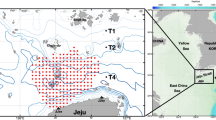Abstract
A practical method to estimate the M2 tidal current is proposed based on one-day current observations. In this method, the semi-diurnal constituent, composed of several constituents within the semi-diurnal frequency band that cannot be resolved from one-day observations, is corrected to the M2 constituent using the amplitude ratio and phase difference between each constituent. The dominant M2 constituent is accurately estimated from the semi-diurnal constituents. However, this method is not always successful for application to diurnal constituents that are much weaker than the M2 constituent. The accuracy of the method depends on the signal-to-noise ratio and the time of observation. Observations conducted during the spring tide period are highly recommended to reduce calculation error. This method was applied along the western and southern coasts of Korea, where the semi-diurnal tidal current is the most predominant component of water circulation. In this study, six major constituents (M2, S2, N2, K2, O2, and 2N2) that are dominant in the semi-diurnal frequency are used for correction of the M2 tidal current. Correction coefficients for S2 and N2 used were the average values from 122 sets of one-month current observations, which have a relatively uniform spatial distribution in the study area. For correction coefficients of K2, v2, and 2N2, we used wellknown constant values determined from the relationships among astronomical forcing factors. The M2 tidal currents after correction are generally well matched to those calculated with the numerical model. The discrepancy between results is mainly due to the complex bathymetry and coastline in the study area, which cannot be fully resolved with a numerical model. A spatial distribution map of the M2 tidal current based on observations in this area is presented for the first time. The method proposed in this study can be used for planning efficient observation of tidal currents.
Similar content being viewed by others
References
Bell C, Vassie JM, Woodworth PL (1999) POL/PSMSL tidal analysis software kit 2000 (Task-2000). Permanent service for mean sea level, CCMS proudman oceanographic laboratory, Bidston Observatory, Birkenhead, 21 p
Blumberg AF, Mellor GL (1987) A description of three-dimensional coastal ocean circulation model. In: Heaps NS (ed) Threedimensional coastal ocean models. American Geophysical Union, Wisconsin, pp 1–16
Choi BH (1980) A tidal model of the Yellow Sea and Eastern China Sea. KORDI, BSPI 00019(3)-36-2, 72 p
Choi BH, Yuk JH, Kim KO (2016) Integral tide-surge-wave model of the Yellow Sea for understanding local sediment transport. J Coastal Res 75:208–212
Emery WJ, Thomson RE (1998) Data analysis methods in physical oceanography. Elsevier, Amsterdam, 634 p
Foreman MGG, Cherniawsky JY, Ballantyne VA (2009) Versatile harmonic tidal analysis: improvements and applications. J Atmos Ocean Tech 26:806–817. doi:10.1175/2008JTECHO615.1
Godin G (1972) The analysis of tides. University of Toronto Press, Toronto, 264 p
Hsueh Y (1988) Recent current observations in the Eastern Yellow Sea. J Geophys Res 93(C6):6875–6884
Kang SK, Lee SR, Lie HJ (1998) Changes in tidal characteristics as a result of the construction of sea-dike/sea-walls in the Mokpo coastal zone in Korea. Estuar Coast Shelf S 48(4): 429–438
KHOA (2012) Thematic maps of ocean science in Korea. Korea Hydrographic and Oceanographic Administration, Busan, 115 p
Lee S, Lie HJ, Song KM, Cho CH, Lim EP (2008) Tidal modification and its effect on sluice-gate outflow after completion of the Saemangeum Dike, South Korea. J Oceanogr 64:763–776
Lee S, Lie HJ, Cho CH, Kang SK, Teague WJ, Chang KI, Song KM, Oh KH (2011) Vertical structure of the M2 tidal current in the Yellow Sea. Ocean Sci J 46(2):73–84. doi:10.1007/s12601-011-0007-x
Lee SH, Beardsley RC (1999) Influence of stratification on residual tidal currents in the Yellow Sea. J Geophys Res 104(C7): 15679–15701. doi:10.1029/1999JC900108
Lie HJ (1989) Tidal fronts in the southern Hwanghae (Yellow Sea). Cont Shelf Res 9:527–546
Lie HJ, Lee S, Cho CH (2002) Computation methods of major tidal currents from satellite-tracked drifter positions, with application to the Yellow and East China Sea. J Geophy Res 107(C1):3003. doi:10.1029/2001JC000898
Lu X, Qiao F, Xia C, Wang G, Yuan Y (2010) Upwelling and surface cold patches in the Yellow Sea in summer: effects of tidal mixing on the vertical circulation. Cont Shelf Res 30:620–632
Moon JH, Hirose N, Yoon JH (2009) Comparison of wind and tidal contributions to seasonal circulation of the Yellow Sea. J Geophys Res 114:C08016. doi:10.1029/2009JC005314
Pugh DT (1987) Tides, surges and mean sea level. Bath Press, Avon, 472 p
Pugh DT, Woodworth P (2014) Sea-level science: understanding tides, surges, tsunamis and mean sea level changes. Cambridge University Press, Cambridge, 395 p
Teague WJ, Perkins HT, Hallock ZR, Jacobs GA (1998) Current and tide observations in the southern Yellow Sea. J Geophy Res 103:27783–27793
Author information
Authors and Affiliations
Corresponding author
Rights and permissions
About this article
Cite this article
Lee, S., Oh, KH., Jang, ST. et al. M2 Tidal Current Estimation from One-day Observation Data off the Western and Southern Coasts of Korea. Ocean Sci. J. 54, 39–50 (2019). https://doi.org/10.1007/s12601-018-0062-7
Received:
Revised:
Accepted:
Published:
Issue Date:
DOI: https://doi.org/10.1007/s12601-018-0062-7



